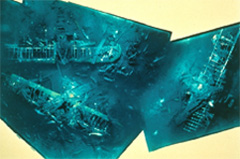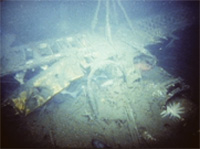In June of 1990, Chris Grech from the Monterey Bay Aquarium Research Institute (MBARI) coordinated with the U.S. Navy's three-man deep submergence vehicle (DSV) Sea Cliff, to locate and document the Macon's remains. During the dives Sea Cliff recovered several artifacts from the site, and collected a definitive image of a Sparrowhawk arrester hook.
MBARI returned to the site in February and April of 1991 and videotaped the site using a remotely operated vehicle. The team located debris fields that included corroded girders, gasoline tanks, the nose-mounted mooring assembly, and the dirigible's German-made Maybach engines. The control car was also located. Although it was flattened, MBARI was able to record windows, chairs, chart tables, and a lead pencil. Four of the Curtis F9C-2 Sparrowhawk biplanes were also located revealing their aluminum frames along with some deteriorated wing fabric still intact. The 1990/91 surveys recorded the bow and mid-section debris fields. During these survey missions MBARI worked with the Navy to collect and distribute artifacts including the arrester hook from a Sparrowhawk. This artifact was conserved at East Carolina University.
 |
Photomontage of Sparrowhawk biplanes from USS Macon wreckage, created by the staff of National Geographic Magazine using footage from ROV Ventana. (Image originally used in January 1992 issue of National Geographic).
Credit: (c) 1991 National Geographic Society |
|
 |
A Sparrowhawk biplane from wreck of USS Macon.
Credit: (c) 1997 MBARI |
|
 |
Close-up view of the front of a Sparrowhawk biplane from the wreck of USS Macon.
Credit: (c) 1997 MBARI |
|



